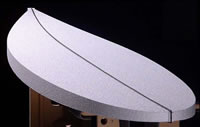Anatomy of Epoxy/EPS Surfboards
Continuing our series on surfboard construction, this week we’ll spend a little time with EPS and Epoxy construction. The goal of these “anatomy” posts is not to give a complete overview of the materials and construction methods, but rather to give the reader a quick look into it’s uses, limitations, pros and cons, and finally to provide some references for further reading. We hope that you will take the time to conduct your own research and make your own conclusions. After all, surfing is fun, and that is why most of us keep coming back to the beach.
EPOXY
“Epoxy or polyepoxide is a thermosetting epoxide polymer that cures (polymerizes and crosslinks) when mixed with a catalyzing agent or “hardener”. Most common epoxy resins are produced from a reaction between epichlorohydrin and bisphenol-A. The first commercial attempts to prepare resins from epichlorohydrin occurred in 1927 in the United States. Credit for the first synthesis of bisphenol-A based epoxy resins is shared by Dr. Pierre Castan of Switzerland and Dr. S.O. Greenlee in the United States in 1936 (Wikipedia – http://en.wikipedia.org/wiki/Epoxy).”
Epoxy in surfboard construction generally refers to the resin used in glassing a surfboard. After the blank is shaped, it is covered in fiberglass cloth (there are other cloths used such as carbon fiber or hemp) and resin is used to bond the cloth to the blank, creating a water-tight finished product. Epoxy resin can be used on wood blanks, polyester and EPS. A primary difference between polyester resin and epoxy is in the release of VOC’s (volatile organic compounds). Epoxy releases at least 50% less VOC’s into the atmosphere than polyester, making it safer for the workers and the environment.
EPS
 EPS or expanded polystyrene foam, is basically the same as a Styrofoam coffee cup. Developments in the production of EPS blanks have resulted in a denser and more water resistant product than in the past. The type of foam used for surfboard construction varies in density, anywhere from .75 lb foam used with sandwich skins (ie: Firewire) to recently developed 3 lb. foam, which would be beneficial for a noserider with a bit more weight. Rocker curves can be hotwire cut to exact tolerances creating a very close-tolerance blank which requires less shaping.
EPS or expanded polystyrene foam, is basically the same as a Styrofoam coffee cup. Developments in the production of EPS blanks have resulted in a denser and more water resistant product than in the past. The type of foam used for surfboard construction varies in density, anywhere from .75 lb foam used with sandwich skins (ie: Firewire) to recently developed 3 lb. foam, which would be beneficial for a noserider with a bit more weight. Rocker curves can be hotwire cut to exact tolerances creating a very close-tolerance blank which requires less shaping.
A quick read through some of the major board manufacturer’s sites will highlight various claims that EPS was born into the mainstream due to Clark Foam’s departure from the scene in late 2005. While this may hold some truth, many small shapers have been shaping EPS/Epoxy boards for many years and with successful results. One of the more prominent names in the current Epoxy craze is Randy French from Surftech. However, Central Florida native Greg Loehr started his company Resin Research in 1981, and has been one of the most imporant influences in todays epoxy technology.
EPS/Epoxy boards have some noticeable differences to the traditional poly boards, specifically in ride and feel. EPS/Epoxy tends to be lighter and more buoyant. In addition, these boards flex differently than poly boards, causing much criticism about it’s value as a true replacement for poly boards. Other noticeable differences are in weight, strength and longevity. EPS/Epoxy construction results in a stronger surfboard. Having said that, it must be added that this also depends on the glassing schedule (see glassing schedule description here). Bottom line -two identical shortboards, one poly and one EPS, with the same glass schedules are not the same animal. Undoubtedly, the EPS board will outlast the poly board.
“Don’t be a barney, barney” Turtle, The North Shore
Fletcher Choinard – Environmental Impact
http://www.pointblanks.com/technology/enviro.shtml
Boarding.com – “..the future?”
http://www.boarding.com/articles/epsfoamsurfboards.html
Eastern Surf Magazine – Greg Loehr Interview
http://www.easternsurf.com/themag/interview75.html
Swaylocks – Epoxy and EPS Construction Primer
http://www.swaylocks.com/resources/detail_page.cgi?ID=1029
sFoam – EPS blank manufacturer
http://www.sfoam.com/GalleryPage.htm
Thanks for the links. I am glassing my first EPS so that really helped.
Homemade boards are the best!!
Thanks, being a new surfer, the technology is a bit confusing at times.
Cheers-
Walt
My EPS surfboard has had a slow leak for over 8 years, and I have discovered that the tail end is where most of the trapped water remains. I have been drying it for several months now, but I wonder if there is a repair technique to remove the water-laden EPS foam from the tail end, and replace it with fresh new EPS foam. Has anybody tried this, or can anyone offer any recommendations?
Hey AHD_310,
Check out this site for some good tips on board repair:
http://www.boardlady.com/repairmenu.htm
Sounds like a pretty major repair is in order, your best bet is to take some pictures and post over at Swaylocks. You’re sure to get an answer there on the best way to repair your board.
http://www.swaylocks.com/forum/gforum.cgi?forum=29
are epoxy boards still hard on the outside like other boards or are they like a foamy?